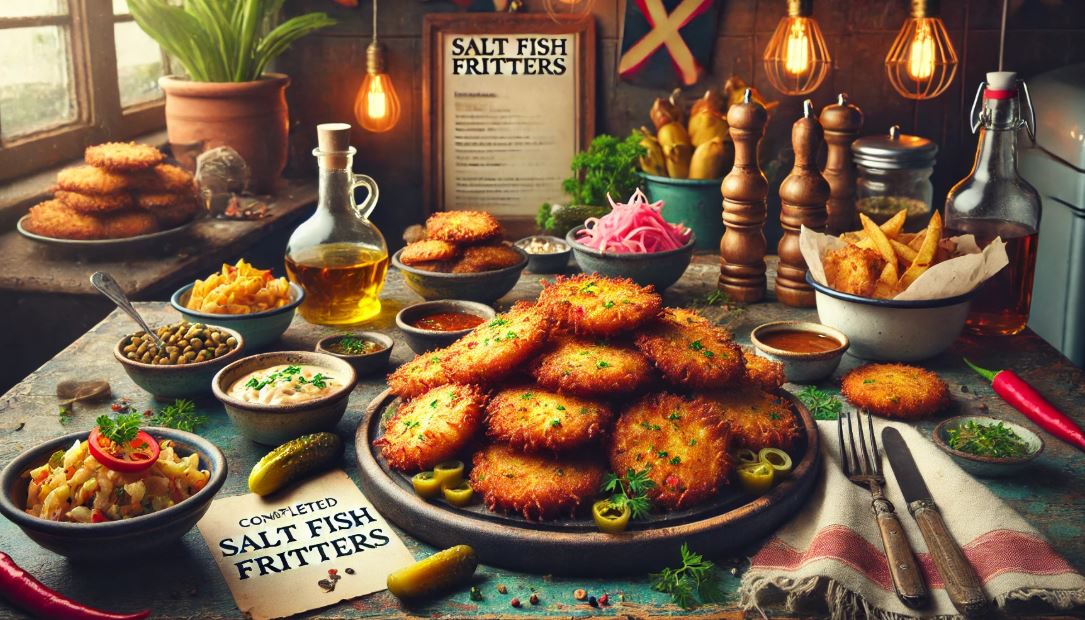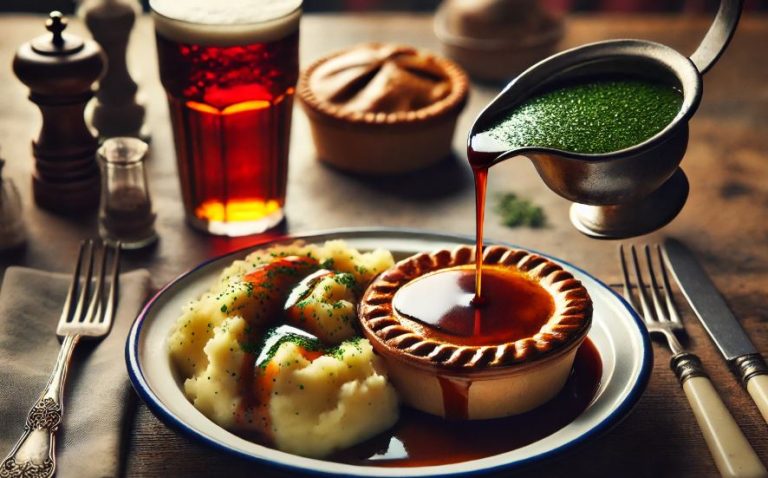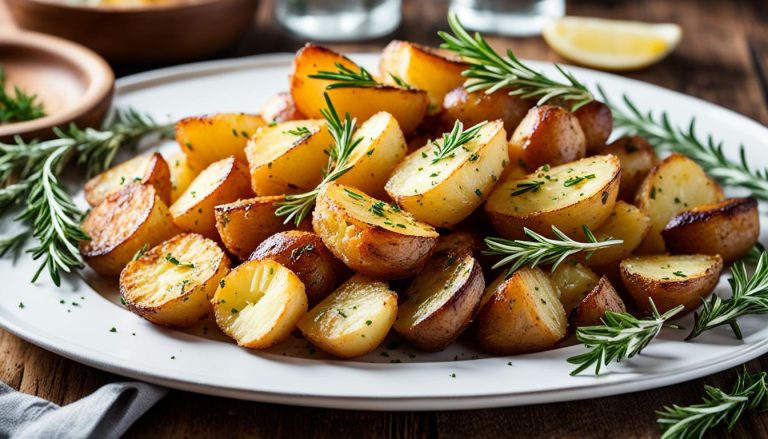Salt fish fritters are a cherished staple across the Caribbean, offering a delicious blend of savoury saltfish, herbs, and spices in a crisp, golden shell. Whether served as a breakfast item, snack, or side dish, this salt fish fritters recipe delivers both flavour and texture.
In the UK, they’ve become increasingly popular due to their bold taste and simplicity. This guide walks through everything from ingredients to variations, ensuring a truly authentic Caribbean culinary experience at home.
What is Salt Fish Fritters?
Salt fish fritters are a beloved dish across the Caribbean, especially in Jamaica, where they are often referred to as “Stamp and Go.” These savoury morsels are made by combining salted codfish with a seasoned flour batter and then shallow-frying them until they are crisp on the outside and fluffy on the inside.
Salt fish fritters are commonly served as breakfast, snacks, or appetisers, and are celebrated for their bold flavours and crunchy texture.
What makes them so special is their blend of traditional island spices, herbs, and salted fish that creates a deeply savoury taste with hints of heat and freshness. Salt fish fritters also hold cultural significance and are considered comfort food for many Caribbean families.
In the UK, salt fish fritters have grown in popularity thanks to the vibrant Caribbean communities and the accessibility of the key ingredients in local shops. These fritters are often enjoyed with dipping sauces or served alongside plantain, salad, or rice dishes.
Whether served at family gatherings or sold in Caribbean street markets, salt fish fritters remain an iconic part of island cuisine that continues to win hearts far beyond the Caribbean shores.
Ingredients for Salt Fish Fritters Recipe?
Creating traditional salt fish fritters requires simple ingredients, many of which can be sourced from local supermarkets or Caribbean grocery stores. Below is a complete breakdown of the core ingredients and optional additions used to customise the flavour or texture.
Salt Fish Fritters Ingredients
| Ingredient | Quantity | Notes |
| Salted codfish (saltfish) | 250g | Soaked overnight or boiled to reduce salt |
| Plain flour | 200g | Acts as the base of the batter |
| Spring onions | 2 stalks, finely chopped | Adds sharpness and freshness |
| Scotch bonnet pepper | ½ or to taste | Optional for heat |
| Garlic | 2 cloves, minced | Enhances savoury depth |
| Fresh thyme | 1 tsp | Earthy herb flavour |
| Baking powder | 1 tsp | For fluffiness and rise |
| Water | ~150ml | Adjust for batter consistency |
| Vegetable oil | For frying | Neutral oil such as sunflower or canola |
| Bell peppers | Optional, finely diced | Adds crunch and colour |
| Black pepper | ½ tsp | Seasoning for balance |
| Sweetcorn, grated carrot | Optional | Additional texture and sweetness |
Optional Add-ins
- Chopped parsley or coriander
- All-purpose Caribbean seasoning
- Grated courgette or spring greens
These ingredients can be adjusted depending on taste preference or dietary needs. Many Caribbean chefs also experiment with air-fried or gluten-free variations using alternative flours such as chickpea or rice flour.
How to Make Salt Fish Fritters Recipe?
Preparing salt fish fritters is a straightforward process, but getting the texture right, crispy outside, soft inside, requires attention to a few key steps. Here’s a detailed guide to making them from start to finish.
1. Prepare the Saltfish

- If using salted cod, rinse off excess salt, then soak overnight in cold water.
- Alternatively, boil the saltfish for 10–15 minutes, discard the water, and repeat if needed.
- Once cooled, remove any bones and skin, and flake the fish into small pieces.
2. Make the Batter

- In a mixing bowl, combine flour, baking powder, black pepper, and fresh thyme.
- Add the spring onions, scotch bonnet, garlic, and any other vegetables like peppers or sweetcorn.
- Fold in the flaked saltfish.
3. Add Water Gradually

- Pour in water a little at a time while mixing until the batter reaches a thick but spoonable consistency, neither runny nor too stiff.
4. Fry the Fritters

- Heat oil in a shallow pan over medium heat.
- Using a spoon, drop small amounts of batter into the hot oil, ensuring they don’t overcrowd.
- Fry each side for about 2–3 minutes or until golden brown and crispy.
5. Drain and Serve

- Remove fritters and place them on kitchen paper to absorb excess oil.
- Serve hot, ideally with dipping sauce or pickled vegetables.
The entire process takes around 30 minutes, making it ideal for both quick snacks and meal prep. The batter can also be made in advance and refrigerated for up to a day before frying.
How Is the Saltfish Prepared Before Cooking?
Saltfish preparation is crucial for achieving the right balance of saltiness and texture in the fritters. Since saltfish is preserved in salt, failing to desalinate properly can make the dish overly salty.
There are two primary methods for preparing the saltfish:
- Overnight Soak Method: Soak the saltfish in cold water overnight. This is the gentlest way to reduce the salt content and helps retain the natural fish texture. Be sure to change the water at least once during the soak.
- Quick Boil Method: For a faster option, boil the saltfish in water for 10–15 minutes, drain, and repeat once more if needed. Let it cool, then remove bones and skin before flaking.
After desalting, the fish should be:
- Soft and easy to flake
- Mildly salty (not overpowering)
- Free of any tough skin or bones
Some cooks also marinate the flaked saltfish in spices before mixing it into the batter to deepen the flavour.
How Do You Make the Perfect Fritter Batter?
The fritter batter forms the base of the dish and influences the final texture—whether they’re fluffy, firm, or doughy. Creating the perfect batter involves balancing the dry ingredients with just enough liquid to create a thick mixture that holds its shape when fried.
Tips for the ideal fritter batter:
- Mix the dry ingredients first to ensure even distribution of baking powder and seasoning.
- Add finely chopped aromatics and vegetables before combining with the saltfish.
- Gradually pour in the water to control the consistency. The batter should be thick enough to drop from a spoon without running.
- Avoid overmixing, as this can activate too much gluten and result in chewy fritters.
- Let the batter rest for 10–15 minutes if time allows, which helps the flour hydrate and the flavours meld.
For added fluffiness, some chefs include an egg or a splash of milk, although this is not traditional. If using gluten-free flour, additional moisture may be required to avoid a crumbly texture.
What Cooking Method Ensures Crispy Salt Fish Fritters?
Achieving a crisp exterior with a soft centre is the hallmark of a great saltfish fritter. The traditional method is shallow frying, although deep frying and even air frying are also gaining popularity.
Key elements for a crispy finish:
- Use a neutral oil with a high smoke point, such as sunflower or canola.
- Heat the oil to around 175°C. If it’s too cool, the fritters absorb oil; too hot, and they burn outside while staying raw inside.
- Fry fritters in batches to avoid overcrowding the pan and dropping the oil temperature.
- Flip each fritter once during cooking, usually after 2–3 minutes per side.
- Drain on kitchen paper immediately after frying to remove excess oil.
While deep frying can yield extra crisp results, it uses more oil and requires precise temperature control. Air frying with a light spray of oil is a healthier alternative, although it may not deliver the same golden crust.
Which Caribbean Islands Popularised Salt Fish Fritters?
Salt fish fritters are enjoyed across the Caribbean, but they are particularly famous in Jamaica, where they are known as “Stamp and Go.” The dish likely originated during colonial times, when salted cod was imported to the Caribbean as an affordable source of protein.
Each island has developed its own take on saltfish fritters:
- Jamaica: Uses scotch bonnet, thyme, and spring onion for a punchy flavour.
- Trinidad and Tobago: May include culantro or shadow beni for a unique herbal profile.
- Barbados: Often adds cornmeal for extra crunch and body.
- St. Lucia: Includes grated carrots and parsley to balance saltiness.
In the UK, Caribbean communities have kept these traditional recipes alive, often adapting them to local tastes or available ingredients. Caribbean food festivals and street vendors in London and Birmingham have helped popularise this snack among broader audiences.
Can Salt Fish Fritters Be Made Ahead or Reheated?
Yes, salt fish fritters can be made ahead of time, making them a convenient option for meal prep or entertaining. While they are best enjoyed fresh and hot, with their exterior crisp and interior fluffy, they still hold up well when stored and reheated properly.
To Make Ahead
- Prepare the batter and store it in an airtight container in the refrigerator for up to 24 hours before frying.
- Alternatively, cook the fritters in advance and store them in the fridge for up to 3 days.
For Freezing
- Allow the fritters to cool completely after frying.
- Place them in a single layer on a baking tray to freeze individually.
- Once frozen, transfer them to a freezer-safe bag or container.
- Label with the date and use within one month for best quality.
To Reheat
- Oven: Reheat at 180°C for 8–10 minutes until hot and crisp.
- Air fryer: Heat at 180°C for about 5 minutes.
- Stovetop: Gently reheat in a frying pan over low heat with a light drizzle of oil.
- Microwave: Not recommended, as it can make them soggy and compromise the texture.
Reheating in the oven or air fryer is the most effective way to revive the crispness without drying them out.
What Dips and Sides Go Well with Salt Fish Fritters?

Salt fish fritters are versatile and pair wonderfully with a range of dips and side dishes, enhancing their savoury and slightly spicy flavour profile.
Popular Dips
- Spicy mango chutney: Offers a sweet heat that contrasts with the salty fritters.
- Tamarind sauce: Tangy and slightly sweet, perfect for balancing richness.
- Garlic mayonnaise: A creamy option to soften the spice.
- Avocado dip: Smooth, cooling, and refreshing.
- Hot pepper sauce: For those who love a strong kick.
Side Dishes
- Fried plantain: Adds sweetness and a soft texture.
- Pickled vegetables: Cuts through the oiliness with acidity.
- Coleslaw: Adds crunch and freshness.
- Coconut rice or rice and peas: Transforms the fritters into a more filling meal.
- Salad with citrus dressing: Lightens the overall dish and refreshes the palate.
These pairings make salt fish fritters suitable not just as snacks but also as components of a larger Caribbean-inspired meal.
Are Salt Fish Fritters Healthy or High in Calories?
Salt fish fritters, while rich in flavour and satisfying, are considered an indulgent food due to their fried nature. However, their nutritional profile depends on preparation methods and ingredient choices.
Typical Nutritional Estimate (per fritter)
- Calories: 100–130 kcal
- Fat: 5–8g (mainly from frying oil)
- Protein: 6–8g (from saltfish)
- Carbohydrates: 10–12g
While traditional fritters are not low-fat, several adjustments can make them healthier:
- Use an air fryer or bake instead of deep frying.
- Swap white flour for wholemeal or chickpea flour.
- Add vegetables like grated carrot, courgette, or spinach to boost fibre and nutrients.
- Control salt by thoroughly soaking the fish and avoiding added salt in the batter.
Saltfish is a good source of protein and omega-3 fats, but it is high in sodium due to its curing process. Those monitoring salt intake should take extra care during preparation.
For occasional enjoyment, especially when paired with light sides and fresh salads, salt fish fritters can certainly fit into a balanced diet.
Conclusion
With just a few pantry staples and this salt fish fritters recipe, anyone can recreate a Caribbean favourite right from their kitchen.
Whether enjoyed as part of a hearty breakfast, light lunch, or party snack, saltfish fritters are versatile, satisfying, and packed with island flavour.
By exploring different variations and preparation methods, home cooks can make this dish truly their own. Serve them fresh and crisp, and they’re sure to impress both traditionalists and newcomers alike.
FAQs
Can I use fresh cod instead of saltfish?
Yes, fresh cod can be used as a substitute, but it will lack the distinctive salty flavour that saltfish provides. Consider seasoning the fish more heavily or adding a small amount of anchovy paste to mimic the depth of saltfish.
What type of flour works best for fritters?
Plain white flour is the most traditional choice. However, self-raising flour can be used to simplify the batter, and gluten-free flours like chickpea or rice flour are excellent alternatives for dietary needs.
Can I make these fritters without eggs?
Absolutely. Most traditional recipes do not use eggs. The combination of flour, water, and baking powder is sufficient to bind the batter.
How do I prevent my fritters from being too greasy?
Ensure the oil is hot enough (around 175°C) before frying. Fritters should sizzle on contact with oil. Also, avoid overcrowding the pan and drain fritters well after frying.
How can I make my fritters spicier?
Increase the amount of scotch bonnet pepper or add a dash of Caribbean hot sauce to the batter. Ground cayenne pepper can also be mixed into the flour for extra heat.
Are these fritters vegan?
Not inherently, due to the inclusion of fish. However, a vegan version can be made using mashed chickpeas or jackfruit in place of saltfish, along with similar seasoning.
What’s the origin of the term Stamp and Go?
Stamp and Go is a Jamaican term used historically for these fritters, often served to travellers or on-the-go workers. The name is believed to have originated from British naval slang.

Salt Fish Fritters Recipe
Ingredients
- 250 g Salted codfish Soaked overnight or boiled to reduce salt
- 200 g Plain flour Acts as the base of the batter
- 2 stalks Spring onions finely chopped, Adds sharpness and freshness
- ½ tsp Optional for heat
- 2 cloves Garlic minced, Enhances savoury depth
- 1 tsp Fresh thyme Earthy herb flavour
- 1 tsp Baking powder For fluffiness and rise
- 150 ml Water Adjust for batter consistency
- Vegetable oil For frying, Neutral oil such as sunflower or canola
- Bell peppers finely diced, Adds crunch and colour
- ½ tsp Black pepper Seasoning for balance
- Sweetcorn grated carrot, Optional Additional texture and sweetness
Instructions
- If using salted cod, rinse off excess salt, then soak overnight in cold water.250 g Salted codfish
- Alternatively, boil the saltfish for 10–15 minutes, discard the water, and repeat if needed.
- Once cooled, remove any bones and skin, and flake the fish into small pieces.
- In a mixing bowl, combine flour, baking powder, black pepper, and fresh thyme.200 g Plain flour, ½ tsp, 1 tsp Fresh thyme, 1 tsp Baking powder, ½ tsp Black pepper, 2 cloves Garlic
- Add the spring onions, scotch bonnet, garlic, and any other vegetables like peppers or sweetcorn.2 stalks Spring onions, Bell peppers, Sweetcorn
- Fold in the flaked saltfish.
- Pour in water a little at a time while mixing until the batter reaches a thick but spoonable consistency, neither runny nor too stiff.150 ml Water
- Heat oil in a shallow pan over medium heat.Vegetable oil
- Using a spoon, drop small amounts of batter into the hot oil, ensuring they don’t overcrowd.
- Fry each side for about 2–3 minutes or until golden brown and crispy.
- Remove fritters and place them on kitchen paper to absorb excess oil.
- Serve hot, ideally with dipping sauce or pickled vegetables.









